Lenovo Yoga 3 Pro Review: Refreshed With Faster Core M
by Brett Howse on March 13, 2015 8:00 AM ESTSystem Performance
For the new model, Lenovo has taken the step of moving from the 15 watt Haswell-U series processors to the 4.5 watt Broadwell-Y based Core M. Their first run of Yoga 3 Pros came with the Core M-5Y70, which has a base frequency of 1.1 GHz, and a boost of 2.6 GHz. Lenovo has refreshed the Yoga 3 Pro to include the 5Y71 processor, which increases the base clock to 1.2 GHz and boost to 2.9 GHz. It will be interesting to see the performance delta between the Yoga 3 Pro and the Yoga 2 Pro.
The Broadwell-Y processors have two cores and hyperthreading. With a thermal envelope of just 4.5 watts though, boost clocks with heavily multithreaded workloads will be reduced as compared to the U series processors. During a multi-threaded run of Cinebench R15, the Core M processor would hover between 1700 and 1800 MHz, but the Core i5-5200U would do the same workload at 2400 MHz and not deviate at all. On single-threaded workloads, the Core M has more headroom to allow the one core to clock higher, and on a single-threaded run of Cinebench R15 it would clock as high as 2600 MHz. However there was a lot of variance during the run, and the Core M-5Y71 would fall as low as 1200 Mhz, with the majority of the time spent between 2000 Mhz and 2200 Mhz. Broadwell-U on the other hand would stay exactly at 2400 Mhz again during the same workload, with very little change in frequency during the run. As compared to Broadwell-U with a 15 watt TPD, the Broadwell-Y limits clock speed quite a bit more. Let’s go through some benchmarks to see how much this affects the Yoga 3 Pro, and especially if the IPC improvements with Broadwell can make up for the lower TDP.
For our benchmarks, I have selected a sample of similar devices in which to compare against. I have also included the Dell XPS 15, which has a quad-core CPU, GT750 GPU, and 91 Wh battery to bracket these scores on the high end. To compare against the low end, I have included the HP Stream 11, which has the Atom N2840 processor. It is interesting to note that the Atom (rebranded as Celeron) has a slightly higher TDP (7.5 watts vs 4.5 watts of the Core M) and it will be a good comparison to see how much more performance Core has than Atom. To compare the Yoga 3 Pro against any other devices, please check out our Notebook Bench.

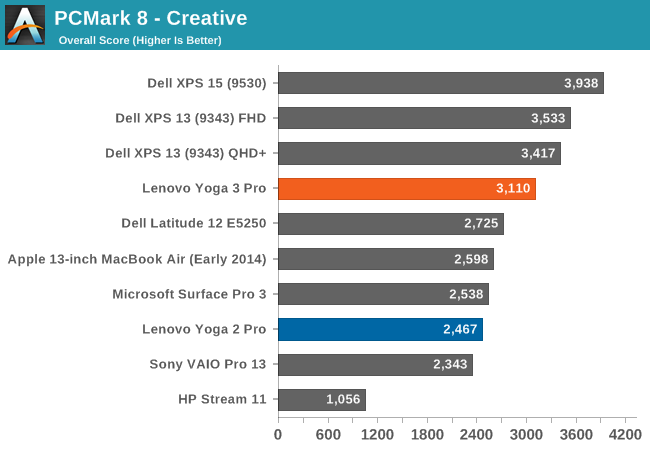
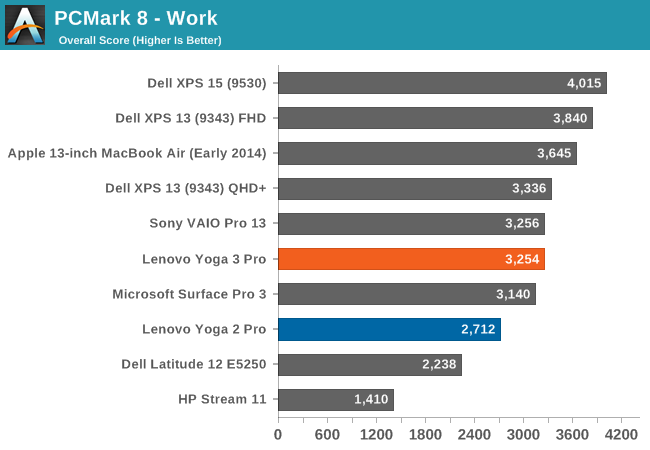
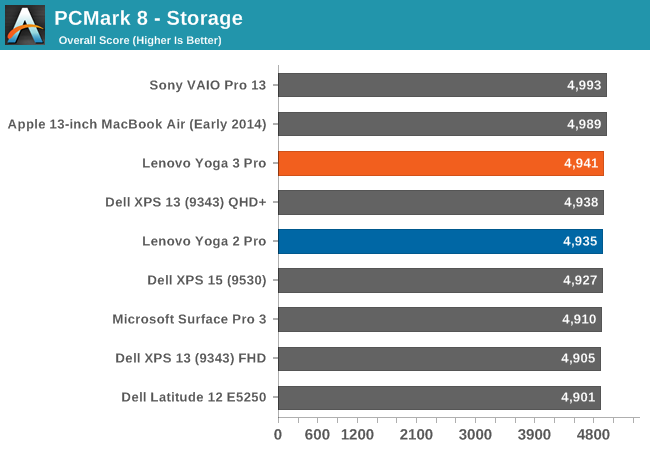
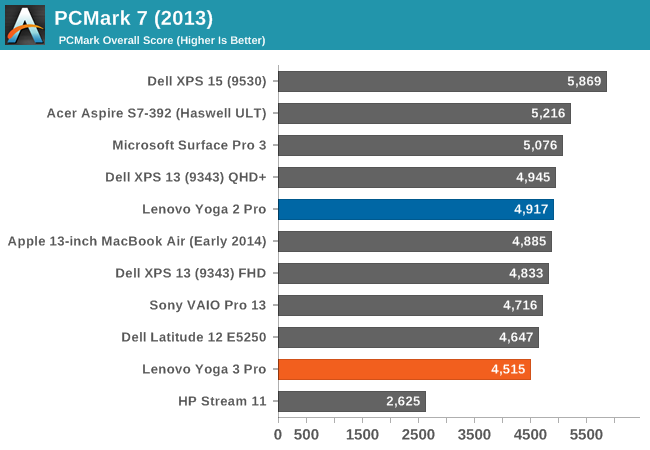
PCMark 8 has four workloads which are Home, Creative, Work, and Storage. Each has a different set of workloads which Futuremark believes represent a good sampling of tasks for each category. Here the Yoga 3 Pro does very well, with scores that are more often than not well above the Yoga 2 Pro’s Core i5-4200U. The Broadwell Core i5s in the XPS 13 still pull a good lead here. The 7.5 watt Bay Trail-M in the HP Stream is sorely outclassed by the 4.5 watt Core M.



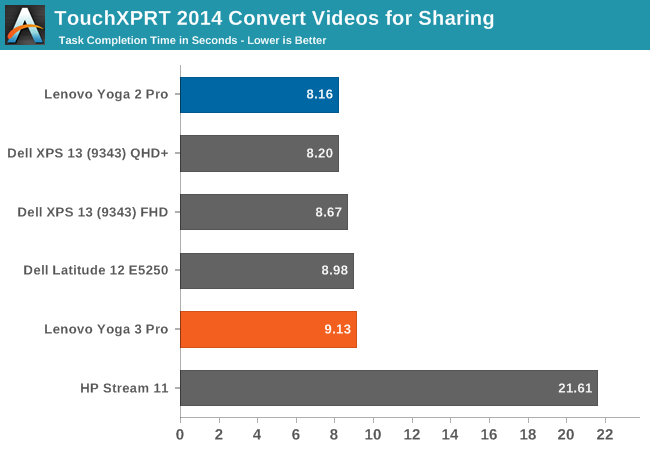
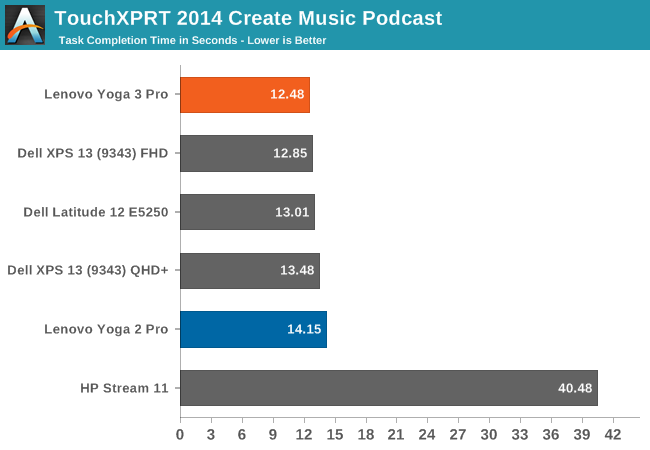

Our next benchmark is TouchXPRT 2014, which is a Windows Store app. It performs several common tasks for a typical home user, and converts the time taken for each task into an overall score. Once again, the 4.5 watt Core M compares very favorably to the 15 watt Yoga 2 Pro processor. In almost all of the tests, Core M is ahead of the Haswell Core i5-4200U of the Yoga 2 Pro. In order to achieve these scores, the GPU driver was updated to the latest version on the Intel site which fixes a problem with the Video Conversion score. We had the same issue with the XPS 13, so if you are the owner of a Broadwell laptop, you may want to update your drivers. The Atom core once again is decimated by Core M.
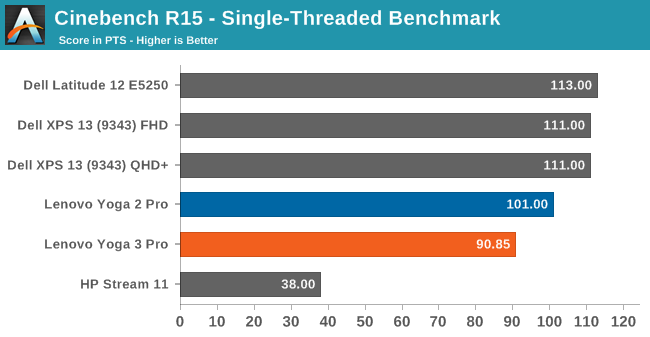

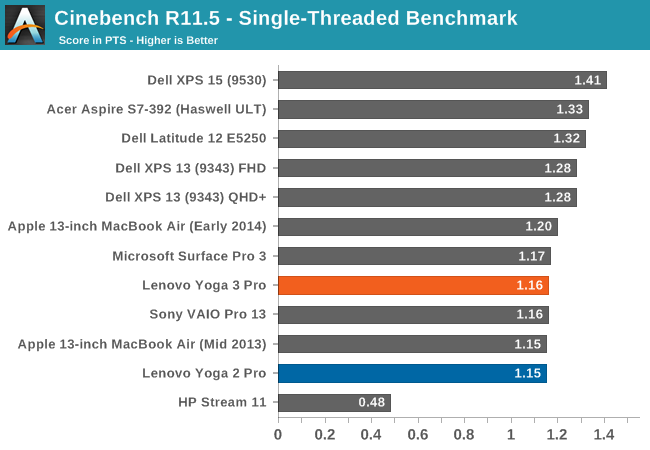
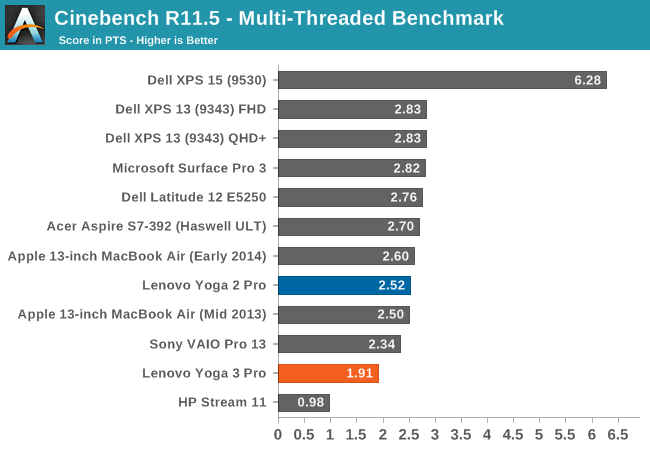


Cinebench is a good long benchmark which shows us how the CPU will perform when maxed out for the duration of the benchmark. Here we can see where Core M starts to falter. On long sustained workloads, it has to cut the CPU frequency to keep within its thermal envelope, whereas the Broadwell-U and Haswell-U CPUs can keep the clocks a lot higher. While running the multithreaded R15, the Core M would hover around 1800-1900 MHz with all cores in use, and the Broadwell-U would lock in at 2400 MHz and stay there for the duration. x264 is similar, and is a very long benchmark. The higher power envelope of the U series processors allow for more work to be done. You can see the quad-core Dell XPS 15 really pulls ahead on these benchmarks, and the HP Stream continues to fall well behind.
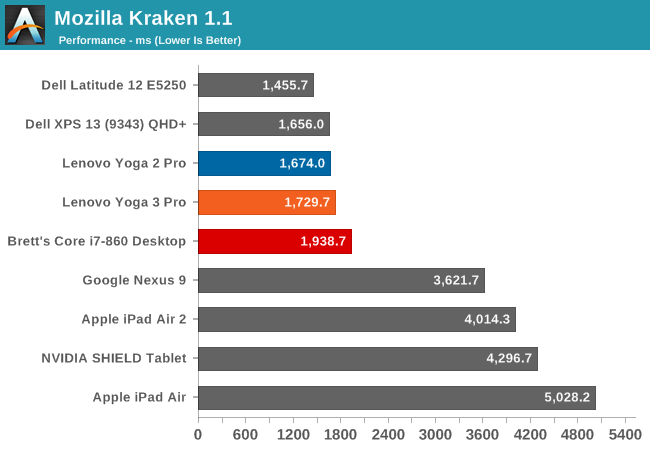

Once again, in web use, the Core M processor is very similar to the outgoing Haswell U based Yoga 2 Pro. Just to put the numbers in a bit more context, I also ran the benchmarks on my Core i7-860 based Desktop (running Chrome, as were the Yogas) and it is pretty clear just how far we have come. The i7-860 is a four core, eight thread 45 nm processor with a 2.8 GHz base clock and 3.46 GHz boost, all in a 95 watt TDP. It was launched in late 2009. Five years later, we have higher performance in a 4.5 watt TDP for many tasks. It really is staggering.
There seems to be a general concensus that Core M equates slow, but clearly this is not the case. For some sustained workloads, yes, the 4.5 watt TDP limits how much performance you are going to get from the CPU, but for many tasks, especially short burst loads, the performance of the 5Y71 is very competitive, often outperforming the Haswell Core i5-4200U from last year’s Yoga 2 Pro. This says a tremendous amount about the Intel 14 nm process, because the IPC improvements of Broadwell vs Haswell are fairly limited. Clearly the CPU has quite a bit of headroom on the 14 nm process to keep the clock speeds up.










113 Comments
View All Comments
Brett Howse - Friday, March 13, 2015 - link
Sorry corrected the TDP info. We can debate about whether it is an Atom or Celeron, but it's really an Atom rebadged.jhoff80 - Friday, March 13, 2015 - link
I think you missed one. "The 5 watt Atom core in the HP Stream is sorely outclassed by the 4.5 watt Core M."kepstin - Friday, March 13, 2015 - link
Not sure what you're saying here... Bay Trail is the latest evolution of Intel's Atom series of processor core designs. While they're not using the Atom brand for it any more, that's still pretty much what it is.azazel1024 - Friday, March 13, 2015 - link
But the point is, it isn't the atom brand. It is the same architecture, but compared to the actual TABLET chips, in some ways it is worse. You have higher TDP, but the CPU is actually worse in a lot of ways, especially multithreaded tests. You've got 2 cores at up to 2.58GHz, where as the top end Atom Bay Trail chips you have 4 cores at up to 2.39GHz. I can attest in long work loads in passively cooled tablets, the z3775 doesn't really seem to throttle...so you have potentially close to a doubling of performance in highly threaded workloads for something like the z3775 compared to the N2840...which makes the whole CPU performance inbalance between "Atom" and "Broadwell M" a heck of a lot less than these tests make it out to be.Oh...there still is, but in highly threaded work loads the inbalance isn't all that much.
On the GPU side of things...well N2840 or z3775 (or other Atom chip), Broadwell M still crushes it.
It'll be interesting to see how the top end Atom Cherry Trail chips stack up. Assuming ZERO IPC improvements (and I assume there will be at least a little), it clocks in ~200MHz faster than Bay Trail and 4x the EUs (Intel was claiming top clocks of 2.6GHz and 16EU for the top end Cherry Trail tablet chips). The current pre-release Intel claims of ~100% faster GPU with no CPU claims right now.
Still makes Cherry Trail a fair amount slower on the GPU side of things, but on the CPU side...that puts it spitting distance with Broadwell M for multithreaded and if there are modest IPC improvements it might actually actually be FASTER in some multithreaded workloads.
extide - Friday, March 13, 2015 - link
It's not hard to imagine a quad core beating a dual core in multi threaded... Remember though, that in normal use, the feeling of it being fast or slow is all about single threaded speed.Also, don't get all confused with the brand names. There are 2 cores, the Atom core and the 'Core' big core -- it doesnt matter whatever brand name they use it is still either Intel's big core or little core.
fokka - Friday, March 13, 2015 - link
i think you are reading too much into the branding. it's still atom, which still means somewhat poor single threading, poor graphics, but quite ok multi threading, since there often are four cores instead of the two cores you get in all of intels other sub-35w mobile parts.i think intel doesn't do itself a favour spreading the celeron and pentium brands to the atom architecture, but here we have it, let's not make it any worse.
Solandri - Friday, March 13, 2015 - link
Intel's marketing division is just trying to confuse people by extending the Celeron and Pentium names to CPUs with the Silvermont architecture, so they can sell computers with cheaper parts for more money.Most people use the term "Atom" to refer to Intel's (current) Silvermont architecture used in Atom, and now some Celeron and Pentium models. As opposed to Intel's Haswell cores (used in Haswell and Broadwell) used in their i3/i5/i7, as well as some of the Celeron and Pentium models.
Since historically the Celeron name was only given to the upper tier architecture (Haswell, Sandy Bridge, Nehalem), it's more accurate to call the N2840 an Atom than a Celeron. Calling the N2840 a Celeron is kinda like calling the 4-cylinder Mustang a Mustang. The performance just isn't there to back up the name.
mkozakewich - Saturday, March 14, 2015 - link
Doesn't "Mustang" mean performance, though? If you get a Celeron computer, you're expecting something cheap and just fast enough to use for basic tasks.extide - Friday, March 13, 2015 - link
...Which means it's an Atom.jabber - Friday, March 13, 2015 - link
First thing I'd do if that was mine? Get rid of those awful stickers.Like those dumb car parts shopping lists muppets stick on their mom's Civic.